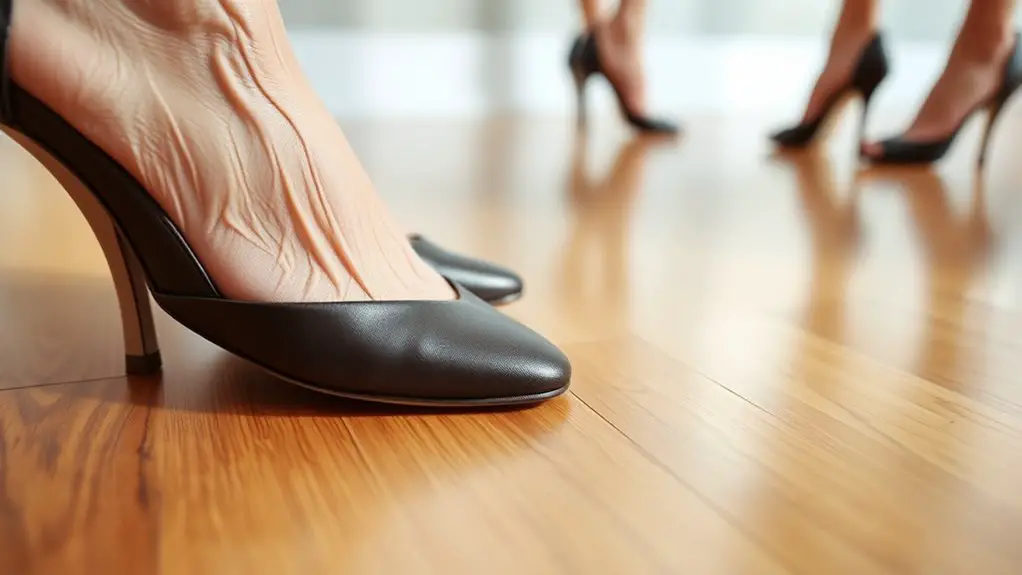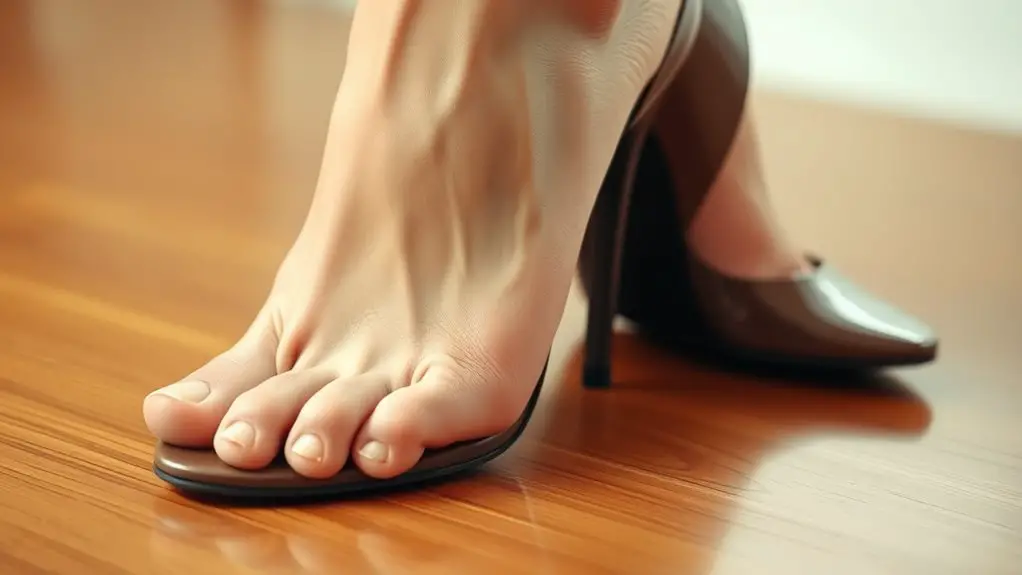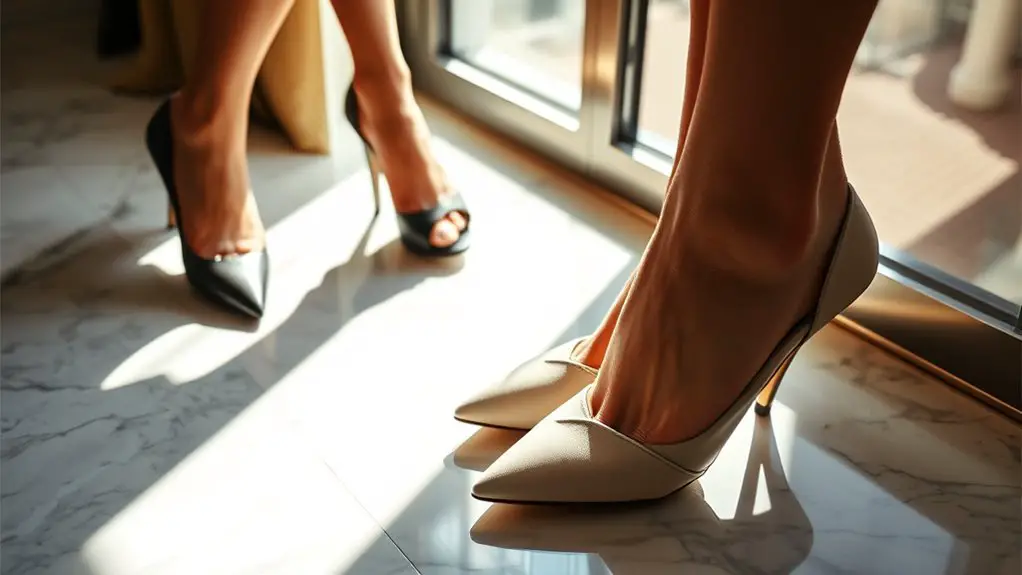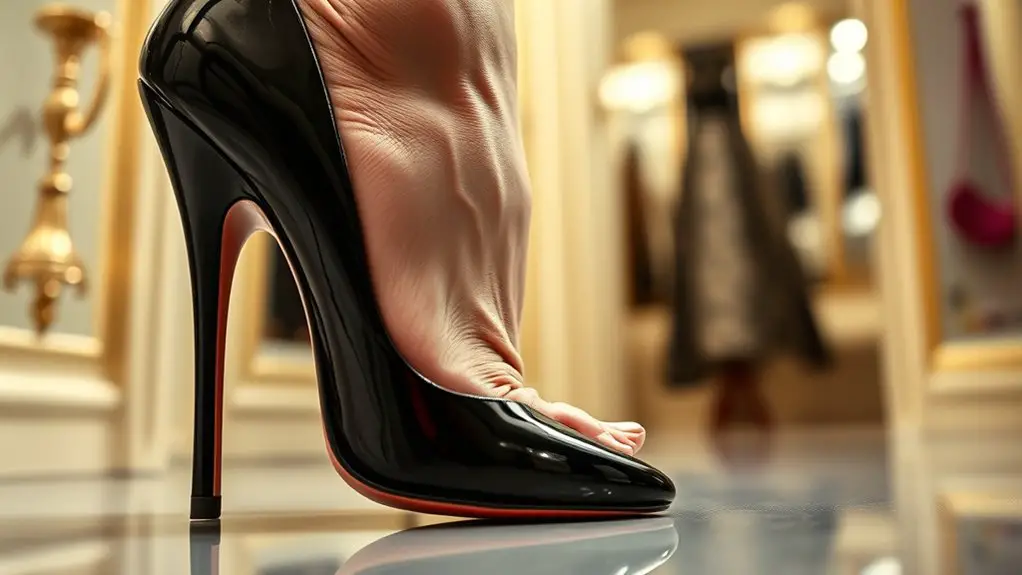Yes, high heels can greatly increase your risk of developing bunions. They alter foot mechanics by shifting body weight forward and exerting excessive pressure on your toes. This unnatural positioning can strain your foot’s structure, leading to a bony protrusion at the base of your big toe. Factors like genetics and poorly designed footwear can also contribute to bunion formation. Understanding the impact of your shoe choices is essential, and more insights on prevention and management await you.
Understanding Bunions: What They Are and How They Develop

Bunions, clinically known as hallux valgus, are a common foot deformity characterized by a bony protrusion at the base of the big toe. They develop when the big toe leans towards the second toe, causing the joint to protrude. Several factors contribute to bunion causes, including genetics, improper footwear, and certain medical conditions like arthritis. Wearing narrow or high-heeled shoes can exacerbate the condition, placing undue pressure on the toes.
Bunion symptoms typically include pain and swelling around the affected area, difficulty in finding comfortable footwear, and inflammation. As the bunion progresses, you may also experience stiffness and reduced range of motion in the big toe. Early intervention can help manage symptoms and slow progression, so it’s essential to recognize these signs and consult a healthcare professional if you suspect you have a bunion. Addressing these factors can lead to improved foot health and comfort.
The Anatomy of the Foot and the Impact of High Heels
An understanding of foot anatomy is essential when examining the effects of high heels on foot health. The foot consists of 26 bones, 33 joints, and numerous muscles and ligaments that work together to provide stability and mobility. High heels, typically characterized by a significant heel height, alter the natural alignment of your foot. This elevated position shifts your body weight forward, placing undue pressure on the toes and the metatarsal bones.
The arch of your foot also experiences strain as it adapts to the altered biomechanics caused by high heels. Over time, this unnatural positioning can lead to various foot problems, including bunions. The pressure exerted on the big toe joint can cause it to drift outward, resulting in painful, bony protrusions. Understanding these anatomical changes helps underscore the importance of choosing footwear that supports healthy foot anatomy.
How High Heels Alter Foot Mechanics

When you wear high heels, the mechanics of your feet undergo significant alterations that can lead to discomfort and long-term issues. The elevated position of the heel shifts your body weight forward, increasing foot pressure on the toes. This unnatural distribution of weight can strain the forefoot and lead to conditions such as metatarsalgia. Additionally, high heels can create balance issues, as the altered angle of your foot affects your center of gravity. You may find yourself relying on your ankle and leg muscles more, leading to fatigue and instability. Over time, these changes can disrupt the natural alignment of your feet, contributing to problems like bunions and other deformities. It’s essential to be aware of how high heels impact foot mechanics to make informed choices about your footwear and maintain your foot health.
Factors Contributing to Bunion Formation
Bunions can arise from a combination of factors, including your choice of footwear, inherited traits, and the natural structure of your feet. High heels often exacerbate the pressure on your toes, while certain genetic factors can make you more susceptible to developing bunions. Additionally, variations in foot structure can influence how load is distributed across your feet, contributing to this condition.
Footwear Choices Impact
While many factors contribute to the formation of bunions, footwear choices play a significant role in exacerbating this condition. High heels and narrow shoes can place undue pressure on your toes, leading to misalignment. Modern footwear trends often prioritize style over comfort, which can further complicate foot health.
Consider the following factors regarding your footwear:
- Toe Box Shape: A cramped toe box can increase bunion formation risk.
- Heel Height: Elevated heels shift weight forward, stressing the forefoot.
- Shoe Materials: Rigid materials can restrict natural foot movement.
- Arch Support: Insufficient support may contribute to improper foot positioning.
Being mindful of these factors can help you make informed footwear choices that protect your feet.
Genetic Predisposition Factors
Although environmental factors like footwear choices are significant, genetic predisposition also plays an essential role in the development of bunions. Research indicates that hereditary factors contribute to the risk of bunion formation, suggesting that if your family has a history of bunions, you might be more likely to develop them. Certain genetic markers have been identified that correlate with foot structure and alignment, which can influence your likelihood of experiencing bunions. These genetic predispositions can lead to biomechanical imbalances that exacerbate the effects of external factors, such as wearing high heels. Understanding your genetic background can help you take preventative measures or seek earlier intervention if you’re at risk for bunions.
Foot Structure Variations
When considering factors contributing to bunion formation, foot structure variations play an essential role. Your unique foot anatomy can greatly influence your risk of developing bunions. Variations analysis reveals how specific traits may predispose you to this condition:
- Metatarsal length: Longer first metatarsals can increase pressure on the big toe joint.
- Arch type: High arches or flat feet alter weight distribution and can exacerbate misalignment.
- Toe alignment: A naturally angled big toe may predispose you to bunion formation.
- Ligament laxity: Loose ligaments can lead to instability in the foot structure, increasing the likelihood of bunion development.
Understanding these variations can help you make informed choices regarding footwear and foot care.
The Role of Genetics in Bunion Development
Genetics play a significant role in the development of bunions, influencing inherited foot structure and alignment. If you have a family history of bunions, your risk may increase due to these genetic predispositions. Understanding these factors can help you make informed choices about foot health and footwear options.
Inherited Foot Structure
While many factors contribute to the development of bunions, inherited foot structure plays a significant role in determining susceptibility. Your genetic variations influence the shape and alignment of your toes, potentially leading to bunion formation.
Consider these inherited traits that may affect your foot structure:
- Foot arch type: Flat feet or high arches can predispose you to bunions.
- Toe alignment: Genetic predisposition can lead to misalignment of the big toe.
- Ligament laxity: Some individuals inherit looser ligaments, increasing bunion risk.
- Foot width: A wider foot may result in more friction and pressure on the toe joints.
Understanding these inherited traits can help you take proactive measures to manage your foot health effectively.
Family History Impact
Although bunions often develop due to various environmental factors, a family history of the condition greatly increases your risk. Genetic predisposition plays a significant role in how bunions form, as hereditary traits can affect foot structure and mechanics. If your parents or siblings have bunions, it’s likely that you’ll experience similar issues due to shared genetic characteristics. Family influence extends beyond just genetics; lifestyle choices and foot care practices may also be passed down. This means that if you have a family history of bunions, you should be proactive in monitoring your foot health. Early intervention and awareness can help manage or potentially reduce the risk of developing bunions related to hereditary factors.
Genetic Predisposition Factors
When considering the development of bunions, it’s clear that genetic predisposition greatly influences foot structure and alignment. Research indicates that specific genetic markers can increase your likelihood of developing bunions, often manifesting in familial traits.
- Individuals with a family history of bunions are more prone to similar foot issues.
- Certain inherited foot shapes can contribute to misalignment and pressure on the big toe.
- Genetic factors can affect ligament elasticity, impacting overall foot stability.
- Studies show that women with a maternal history of bunions have a higher risk of developing them.
Understanding these genetic predispositions can help you make informed decisions about footwear and care to potentially mitigate bunion formation.
Choosing the Right Footwear: Tips for Healthy Feet
Choosing the right footwear is important for maintaining healthy feet, especially if you’re prone to conditions like bunions. When selecting shoes, prioritize footwear materials that offer breathability and flexibility. Look for cushioning technology to absorb shock and reduce pressure on your feet. Adequate arch support is essential, as it helps distribute weight evenly and alleviates strain. A spacious toe box is critical for allowing your toes to move freely, preventing crowding that can exacerbate bunions.
Consider your lifestyle factors when choosing shoes; daily activities may require different features. Balance style vs. comfort by selecting shoes that align with your aesthetic while providing necessary foot health benefits. Always guarantee a proper shoe fit; shoes should be snug but not tight, allowing for slight movement without pinching. By taking these steps, you can considerably reduce the risk of foot-related issues.
Alternatives to High Heels: Stylish and Comfortable Options

While high heels may elevate your style, they often come at the cost of foot health. Fortunately, there are stylish alternatives that provide both comfort and support. Consider these options for your footwear wardrobe:
- Comfortable flats: Available in various designs, they offer a chic look without compromising foot health.
- Trendy sneakers: These not only keep you in style but also provide excellent arch support and cushioning.
- Loafers: A versatile choice, loafers can be dressed up or down, ensuring comfort throughout the day.
- Ankle boots: With low heels and supportive designs, ankle boots can be both fashionable and functional.
Managing Bunion Pain: Treatment and Prevention Strategies
Although bunions can be a source of considerable discomfort, there are effective treatment and prevention strategies to manage the pain and prevent further progression. First, consider wearing wide, supportive shoes that accommodate your foot’s shape, reducing pressure on the bunion. Over-the-counter pain relievers can help alleviate bunion pain temporarily. Custom orthotics may also provide additional support and realignment.
Ice therapy can reduce inflammation after prolonged activity, while foot exercises help maintain joint flexibility and strengthen surrounding muscles. You might also explore padding or bunion splints, which can relieve pressure and improve comfort.
Preventive measures include avoiding high heels and tight footwear, as well as maintaining a healthy weight to minimize stress on your feet. By incorporating these treatment options and prevention strategies into your routine, you can considerably reduce bunion pain and enhance your overall foot health.
When to Seek Professional Help for Bunions
When should you consider seeking professional help for bunions? If you’re experiencing persistent discomfort or other troubling bunion symptoms, it might be time to consult a healthcare provider. Early intervention can help prevent further complications.
If you’re facing ongoing discomfort from bunions, consulting a healthcare provider early can prevent further issues.
Consider seeking professional help if you notice:
- Severe pain that limits daily activities
- Swelling or redness around the bunion
- Difficulty finding comfortable footwear
- Development of corns or calluses due to bunion friction
A healthcare professional can evaluate your condition and recommend appropriate treatment options. These may include custom orthotics, physical therapy, or, in more severe cases, surgical intervention. Ignoring bunion symptoms can lead to worsening pain and mobility issues. If you’re unsure, it’s best to err on the side of caution and consult a specialist to discuss your symptoms and potential solutions.
Frequently Asked Questions
Can Bunions Form Without Wearing High Heels?
Yes, bunions can form without wearing high heels. They’re influenced by genetic factors and other causes like foot structure, arthritis, and certain medical conditions. Keeping feet healthy and well-supported is essential for prevention.
Are Bunions More Common in Women Than Men?
Bunions are indeed more common in women than men, largely due to anatomical and hormonal gender differences. While genetics and footwear choices contribute to bunion causes, gender plays a significant role in prevalence rates.
Do Bunions Always Require Surgical Intervention?
Bunions don’t always require surgery; many find relief through non-surgical options like orthotics or physical therapy. However, if symptoms persist or worsen, consulting a specialist’s essential for a tailored treatment plan.
Can Bunions Affect Balance and Stability?
Bunions can indeed lead to balance issues and stability concerns. Their altered foot structure may affect how you distribute weight, increasing the risk of falls or discomfort during movement. Addressing bunions early can help maintain stability.
What Age Group Is Most Susceptible to Developing Bunions?
As you age, like an antique vase, your feet can show wear. Age-related factors and genetic predisposition make older adults more susceptible to bunions, as their foot structure often changes over time, increasing discomfort.



